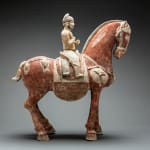Tang Sculpture of a Horse and Foreign Rider, 600 CE - 700 CE
Terracotta
height 50.8 cm
height 20 in
height 20 in
H.688
Further images
This general type of Chinese burial art is known as mingqi. Mingqi were any of a variety of objects specifically created for interment in the tombs of elite individuals in...
This general type of Chinese burial art is known as mingqi. Mingqi were any of a variety of objects specifically created for interment in the tombs of elite individuals in order to provide for the afterlife. Many of these works reflect Chinese contact with a variety of foreigners including Jewish merchants, Persian traders, and various tribes from Central Asia who were essential for their supply of fine steeds. The great influence of the horse throughout the history of China cannot be underestimated. In fact, the ancient expansion of the Chinese Empire was due in large part to the horse. The rapid mobility of horses allowed for quick communication between far away provinces. Likewise, the military role of horses aided in the defense of the borders from nomadic invaders as well as the conquest and submission of distant lands. The need to import stronger, faster steeds from Central Asia (as opposed to the local Mongol pony) led to the creation of the Silk Road. The importance of the horse in the history and culture of China can be viewed, in part, through the artistic legacy of this great civilization. In sculpture, painting, and literature, horses were glorified and revered. Furthermore, horses were believed to be relatives of the mythological dragon, reflecting their sacred status within society. This sculpture depicts a foreigner riding horseback; his hat, nose, and beard reveal his foreign statusMost probably, he was merchant from the Turkish tribes of Central Asia working the Silk Road. Perhaps he has brought this steed to China in order to trade for precious silk. The early dating of this work is reflective of the stylization of the horses head and legs that were characteristic of the preceding Sui Dynasty. Overall, this sculpture is a testament to the revered status of the horse in Chinese culture, a love that reached new heights of expression during the T’ang Dynasty.





